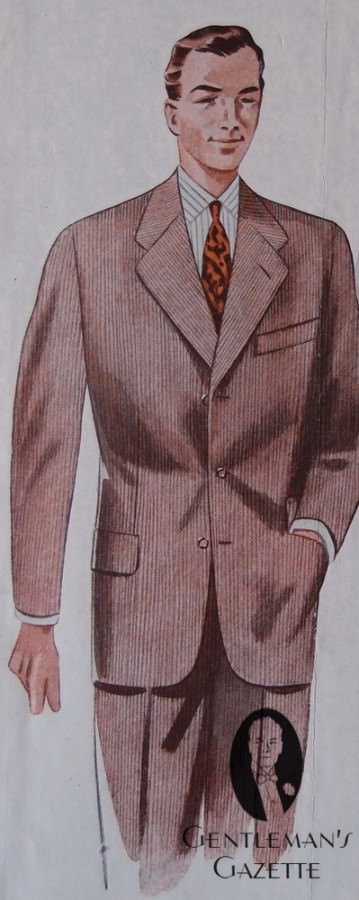In the past, we have dedicated many of our fashion illustration articles to the glorious men’s fashion decades of the 1920’s and 1930’s. Occasionally, we have also featured the 1960’s, but the there does not seem to be much conversation about the suit styles of the 1950’s. As such, we would like to discuss the several suits and overcoats using pictures and illustrations from Germany, circa 1951.
Compared to the 1940’s, the 1950’s coats were cut slimmer and a bit shorter.
The Jacket

1950’s bespoke coats were generally not cut narrowly by today’s standards, but unlike many suits from the prior decade, they featured a noticeable waistline. Shoulders remained slightly padded and wide. The collar was wider and rather short, so you could see more of the shirt collar underneath. The lapels’ gorge was not overly angled down but rather more moderate, and the closing button was located just below the natural waistline.

Single breasted coats were mostly cut with 2 or 3 buttons – depending on the wearer, the front quarters were now cut more open and round than they previously were. While vests were considered to be the proper attire for business suits, double breasted suits were no longer worn with a vest.
Double breasted jackets were clearly outnumbered though not extinct. For those who did wear them, they would feature wide pocket flaps and a low buttoning point, exposing a lot of the shirt front.

The peaked lapels were not overly pointy and underlined the width of the shoulders.
Sportscoats featured patch pockets and were regularly made of Cheviot tweed.
The Trousers
Unlike to jacket silhouette, the 50’s trousers remained mostly unchanged. They were cut fuller around the bust and featured one or two pleats in the front. In Germany, they often tailored these pleats facing outwards, while the British tailored them often facing inwards. A regular trousers cuff measured around 9.5 inches (24cm) and was much wider than what you see on most suits today. Cuffs were often up to 2.5 inches (6cm) wide and cut so short, that it would just slightly touch the shoe and create only a slight break. Today, most men in the US wear their cuffed trousers much longer, leaving a big, sloppy break in the front. While pants of the rank are cut straight along the cuffs, bespoke trousers often feature a slight slant, which improves the look without adding a huge break. As you can imagine, it involves much more work to create a slanted cuff and therefore it is a particular indicator of bespoke trousers.

Overcoats & Topcoats
The Paletot was cut with just a hint of a waistline and was offered as a double breasted version in addition to a single breasted cut.
More casual overcoat variations such as the Ulster were previously tailored in lighter fabrics for warmer weather, although by current standards, all of these fabrics were quite heavy.
All of them were tailored with enough fabric in the back for added comfort.

Formalwear
Throughout the decades, formalwear has changed has changed the least.

However, in the 1950’s, white or ivory dinner jackets were more popular than they are now – especially for warm summer evening events. Of course, the average man on the street would never own one, but a clotheshorse would definitely have at least one white or off-white jacket and some would even wear them in dove grey or pastel colors.
The dinner jacket in this illustration has just 2 two horizontally spaced buttons, which gives it unique look. Personally, I would probably not opt for this kind of button closure, but if you want something special – here you go.
The morning coat was also worn with a lighter colored trousers and some even went so far as to invest in a matching three piece morning suit.
What do you think of the 50’s fashions? Do you find them to be as wearable as some we’ve highlighted from the 20’s and 30’s?

An interesting take on the oft overlooked decade … And perhaps for reason as following WW2,.things could not have been groundbreaking in the world of style then but more towards economy and stabilisation in view.
This is good info for a school project. You should get more info on hair,shoes etc.